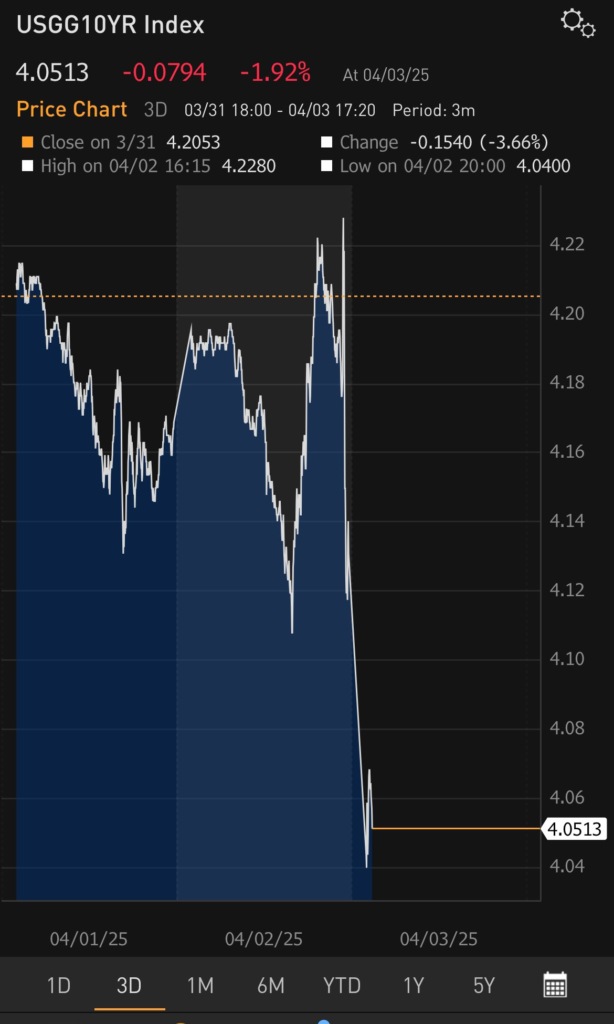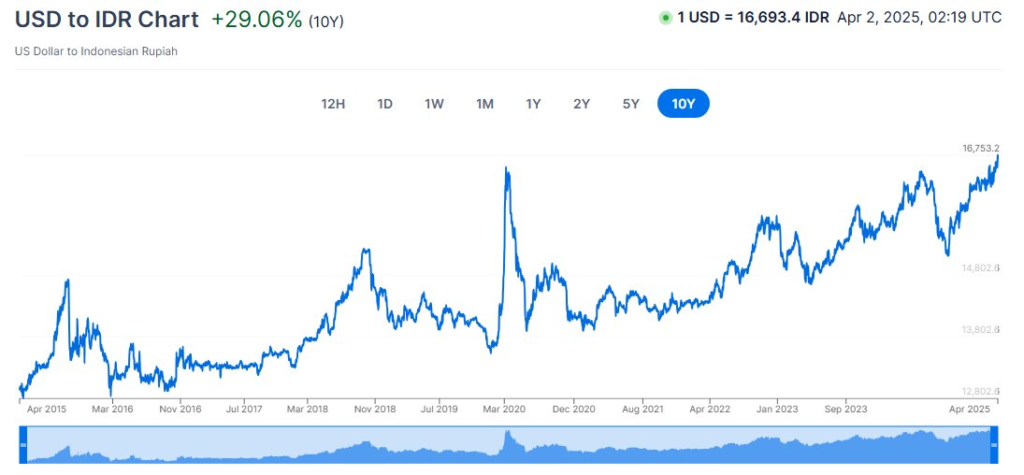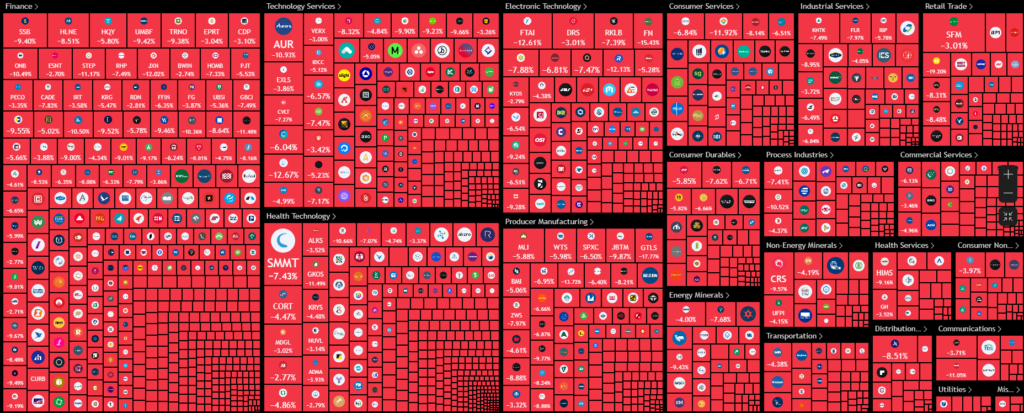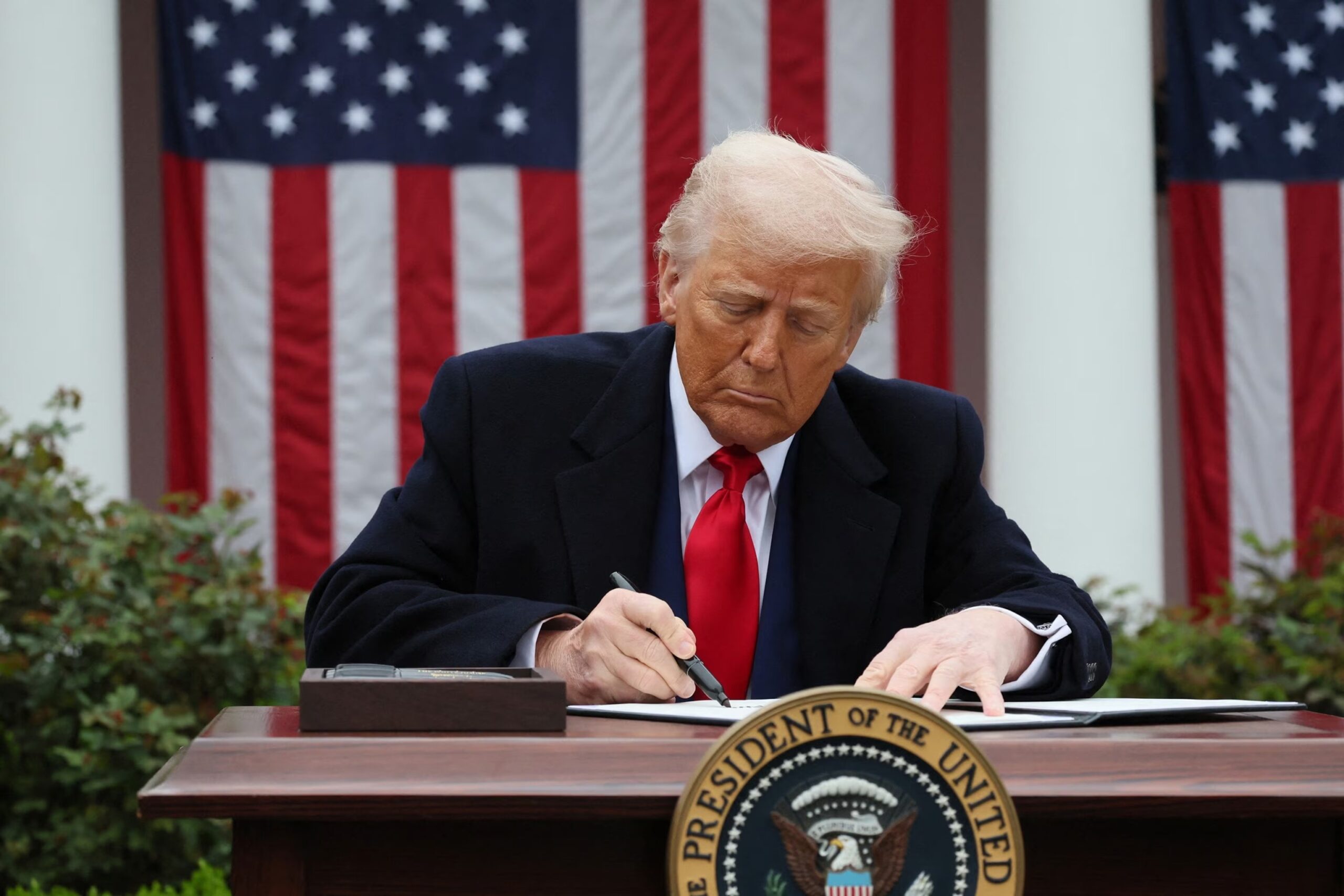If you’ve watched Attack on Titan, you already know the title at the first glance. That is the iconic opening narration from the anime, spoken during the first episode when humanity was brutally reminded of the existence and threat of the Titans.
Eren Yeager—once the protector of Paradis Island—flipped the script, deciding the only way to ensure peace at home was to trample the rest of the world. Not with diplomacy, but with destruction. The infamous Rumbling wasn’t self-defense. It was deterrence by annihilation.
Now swap the man-bun for a red tie and a teleprompter. Trump’s “Liberation Day” channels the same philosophy: “If you threaten us, we will tear down global trade just to make sure we’re on top of the rubble.”
Tariffs hit like Wall Titans. Wide, deliberate, and designed to instill fear. The result?
Stocks collapsed. Crypto retreated like scouts out of ODM (Omni-directional Mobility Gear) gas. Gold surged as investors ran for safety.
Yields dropped—because who needs optimism when you’re staring down a macro apocalypse?

When Pain Is the Policy
Let’s be clear—tariffs are bad and painful. But, deep down in Trump’s mind, tt was about triggering pain—intentionally. According to folks like The Kobeissi Letter, the Trump team is playing 4D chess with a sledgehammer:
- Spark a recession.
- Kill inflation.
- Crash yields.
- Refinance $9.2 trillion in debt before it detonates in 2025.
It’s not a growth strategy. It’s a controlled demolition. Rebuild the fortress after the smoke clears.
But first? Let it all fall.
“The enemy is the world” — and the market got the memo.
What Tariffs Actually Do
Let’s back to basic first. Ray Dalio breaks it down better than any military strategist in Marley.
Tariffs are not just economic tools—they’re political power moves masquerading as domestic protectionism. Here’s the anatomy of a tariff through Dalio’s lens:
- First-order effect: A tariff is a tax. It raises prices for consumers and producers alike. The importer suffers inflation, the exporter suffers deflation. Everyone suffers, but in very different ways.
- Second-order consequences: Countries retaliate. Currencies devalue. Central banks get dragged into the brawl with rate cuts or hikes, depending on which way the economic wind blows. Fiscal policy becomes the band-aid for bleeding trade flows.
In short: Tariffs are blunt weapons. You don’t use them to heal—you use them to wound strategically.
And Trump “strategically” put Tariffs to many many countries (my home country included).
Strategic, Not Just Spiteful
As nonsense as it seems, surprisingly some still laid of a pragmatic defense of tariffs, suggesting they aren’t just a blunt weapon—but a multifaceted tool of economic statecraft:
- Addressing Unfair Trade Practices: The U.S. opens its markets while others slap on barriers. Tariffs could act as leverage to negotiate better deals.
- Reducing Dependence on China: The hope that China’s economic rise would lead to political reform hasn’t played out. Diversifying supply chains is now a national strategy.
- Opportunities for Allies: Countries like Vietnam, India, and Malaysia could benefit if they play it smart—lowering trade barriers and soaking up manufacturing leaving China.
- Reshoring Potential: Not all production will return to the U.S., but some might. Tariffs could spark small-scale industrial reboots.
- Revenue Generation: The U.S. needs cash. Tariffs act like a consumption tax on imports, helping fill the budget hole.
- Tax Balance: The U.S. leans on income taxes. Most other nations tax spending. Tariffs could level that asymmetry.
TL;DR: It’s taxation, yes—but with purpose. Tariffs can be used to rebalance trade, not just bully the block.
The Math Behind the Madness
Online sleuths—armed with calculator cores and X (formerly Twitter)—uncovered that Trump’s “tariff math” was cooked like Liberio propaganda.
He claimed tariffs were calculated using this gem: trade deficit ÷ imports = tariff rate.
The administration said that is not the case. It is actually more complicated and sophisticated.

But the point is practically the same: that’s not a real tariff rate.
That’s just cosplay economics. When the numbers didn’t fit the narrative? He slapped on a flat 10%. No ODM gear needed.
A policy built on vibes and intimidation. Just like Eren’s final push—it’s not about logic. It’s about sending a message.
What It Means for Emerging Markets (RIP Indonesia)
Trump’s tariffs practically imposed to every country at least 10%. If you’re an emerging market like Indonesia (my lovely home country), that tariff does not mean trade war—it’s economic euthanasia.
Capital Outflows on Full Blast
As global trade seizes up, investors flee risk. Indonesian equities? Still green when almost every ASEAN index is red, thanks to 7-day straight public holiday. When it opens, it will be bled dry. Rupiah? Getting clapped like a scout squad in the fog.

The Growth vs. Currency Trap
Indonesian government left with 2 option then:
- Stimulate growth and watch the Rupiah collapse,
- Or defend the Rupiah and choke growth with austerity.
There’s no win here. Only choices between lesser losses.
Lost Allies, Closed Gates
With the U.S. raising walls and China slowing down, Indonesia’s trade routes are closing like the outer gates of Shiganshina. Exports stall. Capital flees. Currency weakens.
This Isn’t a Trade War. It’s a Liquidity Siege
Trump’s tariffs are the opening act. The real conflict is over who controls liquidity—who gets to keep the capital, who gets to borrow it, and who ends up outside the wall when the smoke clears.
Indonesia’s net bank balance is already -1.7% of GDP. Capital outflows have doubled. Export repatriation mandates (DHE-SDA) are nice on paper—but only if the money isn’t already hiding behind shell companies and invoice smoke screens.
The Rumbling isn’t coming. It’s here. And it’s denominated in USD.
How global market react
Market react the way it should:
- S&P 500 saw a brutal drop of -2.93%, its worst one-day performance since the last inflation panic.
- Nasdaq? Down -3.7%, as traders panic-rotated out of AI and back into “whatever doesn’t bleed.”
- Gold shot up over 2% intraday, its largest surge in months—because when the U.S. goes to economic war, metal gets the bid.
- Bitcoin? Smashed by over 5%, reminding everyone that “digital gold” still trades like “tech with extra seasoning.”
- Bond yields collapsed, pricing in recession like it’s already here.
But the post from The Kobeissi Letter is making a key observation about market behavior, particularly around the S&P 500 and the Volatility Index (VIX). Let me break it down simply:

What’s happening?
- The S&P 500 had a big drop of -4.8% in a single day.
- Normally, such a sharp drop triggers panic, which is reflected by a spike in the VIX (Volatility Index).
- But this time, the VIX stayed below 30, which is historically unusual.
⚠️ Context: The VIX is often called the “fear index” — the higher it goes, the more fear (or panic) is priced into the market.
That is actually pretty interesting phenomenon.
What’s the key insight?

There has NEVER been a day when the S&P dropped more than 4.5% without the VIX jumping above 30 — until now.
- This suggests that selling has been “orderly,” not panic-driven.
- The market may still believe in the fundamentals or is simply rebalancing rather than reacting emotionally.
Why this is interesting:
- Usually, sharp drops = fear = spike in VIX.
- This divergence implies no mass capitulation (panic sell-off) has happened yet.
- There could still be more downside if fear starts kicking in — or this could be a sign of controlled, technical selling by large institutions.
- The VIX has not reached previous highs from March 10 or August 5.
- Even with a huge S&P drop, the VIX is just around 27.68 — not extreme. Yet.
Despite a sharp -4.8% drop in the S&P 500, the VIX stayed unusually low, suggesting the market sell-off has been calm and controlled — not panic-driven. This is very rare and could either mean strength (buyers waiting) or a calm before more volatility.
Tariffs might be policy on paper, but in the market? They’re treated like contagion.
Final Thought
Trump’s Liberation Day isn’t about protection. It’s about resetting the board, with the U.S. holding all the remaining chips.
- Financially: Force a liquidity pivot.
- Politically: Look tough.
- Globally: Wreck supply chains to reclaim leverage.
If you’re holding anything risk-on—especially in emerging markets—you’re not just exposed. You’re out in the open. The market has no ODM gear left for you.

🪙 Hold tight. This isn’t the final episode—but it’s probably the one that defines the arc.


Leave a Reply